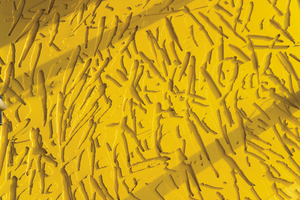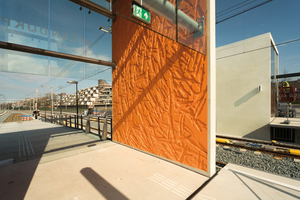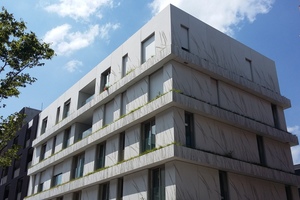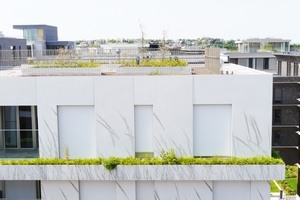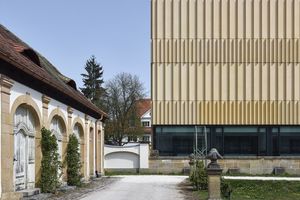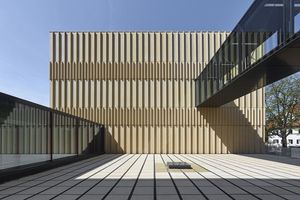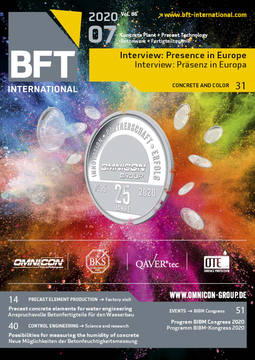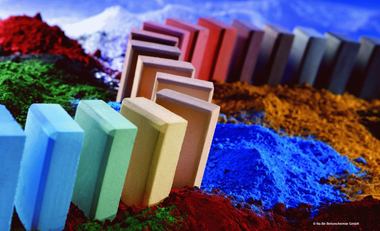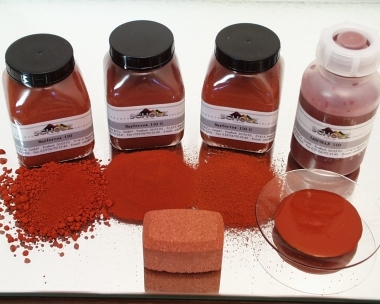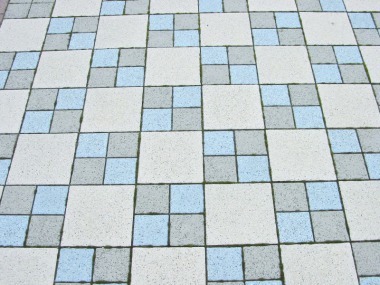Influencing factors for the successful
coloring of concrete
When it comes to concrete, opinions tend to differ sharply: Some people associate concrete with the soulless monotony of old prefabricated slab buildings, while others relate it to coolness and minimalist elegance. Concrete has much more to offer than just „fifty shades of gray“. It can be colorful, offering various options to modify its appearance.
When it comes to concrete, opinions tend to differ sharply: Some people associate concrete with the soulless monotony of old prefabricated slab buildings, while others relate it to coolness and minimalist elegance. However, most people think of a gray building material. But concrete has much more to offer than just „fifty shades of gray“. It can be colorful, offering various options to modify its appearance.
Color of cement
An important factor for the inherent color of concrete is the cement. Depending on the quarrying region and the manufacturing process, its color spectrum can range from light gray up to dark gray and even reddish brown. If concrete is colored with the aid of pigments or the like, the color of the cement plays a particularly important role – especially in case of light colors as yellow, for example.
To achieve clear concrete colors when using pigments, it often requires the use of white cement. Because of its very low iron content, it impresses – as the name suggests – with its radiant white color. Therefore, a wide range of colors can be realized in concrete. To some extent, for many a building even white cement is mixed with black or gray pigments in order to achieve a very specific shade of gray.
Aggregates
With an amount of about 70 vol.%, aggregates account for the largest proportion of the concrete composition. As a consequence, they make an important contribution to the inherent color of the concrete. It is however necessary to distinguish whether the upper concrete layer has been removed or kept, because the cement paste encloses the aggregate particles. It happens time and again that this does not take place completely or the upper concrete layer may be eroded due to weathering over the years. Moreover, precast concrete plants can expose the aggregates deliberately by sandblasting, acid treatment or with the aid of surface retarders, for example.
In this case, from afar, the observer only perceives a mixture of the inherent colors of the aggregates, cement and pigment, if any. Therefore, it can make sense to manufacture the concrete with aggregates featuring a particular color. Even other materials, such as alkali-resistant glass, are added to the concrete time and again. The exposure of the aggregates can also be advisable if the concrete surface is to get a consistent coloring.
Formwork
As soon as the cement gets into contact with water, fine crystal needles form and interlock with each other, i.e. the concrete is hardening. In this regard, the right mixing ratio of water and cement (w/c ratio) is of particular importance for the hardness and the inherent color of the concrete. The larger the w/c ratio, the more pores occur in the concrete. The pores scatter the light and have the concrete appear brighter.
This fact not only has to be taken into account for the concrete formulation but also for the formwork. An absorbing formwork such as wood extracts water from the concrete, thus actually providing for a lower w/c ratio. Absorbing formwork is well suited for pigmented concrete, even though it will have the concrete appear somewhat darker. A non-absorbing formwork involves the danger of the formation of pores and marbling and/or clouds.
Release agent
The influence of release agent on the concrete color is frequently underestimated. However, it has an enormous impact on the appearance of concrete – even when used correctly. For that reason, preliminary tests are absolutely required, and it is necessary to use always the same release agent for a fair-faced concrete building. A common mistake is the wrong application of the release agent. The selected product must be applied uniformly over the full surface of the formwork. But beware: too much release agent can result in unsightly discolorations and, in the worst case, non-uniform hardening of the concrete. Therefore, it is recommended to remove excess material with a lint-free cloth or a scraper.
Curing conditions
Concrete hardens as the cement paste is forming crystals of varying sizes. Higher curing temperatures, as a rule, result in finer crystal needles. The size of the crystals has an effect on how strongly the light that strikes the concrete is scattered. Fine crystal needles scatter the light more than coarser ones. As a consequence, the concrete appears brighter. This phenomenon, however, can be seen with the naked eye only if the temperature difference has reached a certain magnitude. This applies, for example, in case of a steam-hardened concrete and a concrete hardened at room temperature.
Finishing treatment
To protect the concrete in the long run, a hydrophobic treatment and/or a graffiti protection can be applied. It is however important to know that this may have an influence on the appearance of the concrete too. Some products leave a certain shine on the surface that becomes clearly visible depending on the position of the sun. This may be a problem, for example, in case of graffiti protection if only a certain section has been treated with the product like the first floor and the rest of the façade remains untreated. In this example, an intended separation can be reasonable, e. g. that the façade is protruding or recessed in this section. Some graffiti protection products are pigmented as standard so that the concrete can be painted. Another pretty option to color the surface of concrete are scumbles.
Pigments
For the coloring of concrete, pigments as powder, liquid or granules are available on the market. These are inorganic, inert additives made from metal oxides, carbon or carbon black, which can be mixed together and thus tailored to respective design requirements. The amount of pigments added is calculated in relation to the cement. As a rule, the dosage of pigments used in concrete is between 2 and 8 percent of the cement content. In this regard, it should be considered that the color intensity increases linearly with the amount of pigment at first, however, at a certain percentage – the level of color saturation – it stagnates. Then, an addition of further pigments hardly shows any effect.
An important quality criterion of pigments is their color strength. It describes how good they transfer their inherent color to the media to be colored. This can be an important economic factor. Hence, it may be the case that a specific pigment has a favorable purchase price but features a low color strength. This can possibly result in the fact that more of this pigment has to be added to the concrete in order to obtain the desired color shade.
Avoiding discrepancies
Concrete is a building material providing an extraordinary wide variety of different possibilities for design. It cannot only be designed in any required shape but its surface properties and color can be modified too. So as to ensure always a constant color shade for a building structure, there should be as few fluctuations as possible in both the mix design and the production factors. Only pigments and/or pigment preparations, for example, are standardized regarding color shade and color strength.
This is not possible for natural products such as aggregates and only to a limited extent for cement. Therefore, it can be reasonable to purchase some concrete constituents, such as aggregates, in one lot and to store them in the factory. Whereas, concrete plants have only little influence on other factors, as the temperature and the air humidity, for example. Therefore, it is not always possible to achieve an absolute identical coloring. In order to avoid discrepancies at the end of the construction process, all parties involved should really be aware of these aspects.

